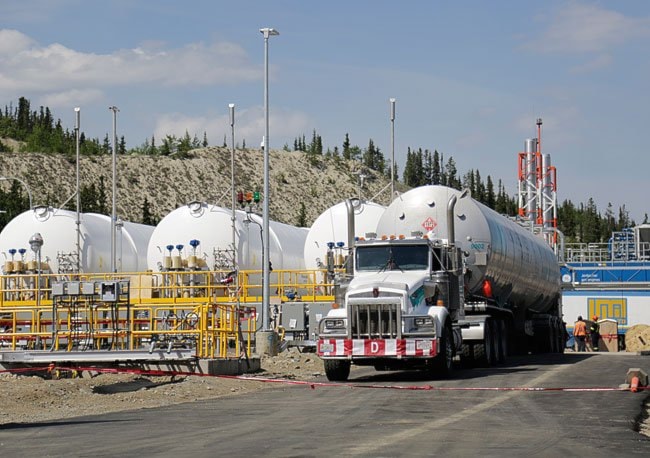Yukon Energy’s liquefied natural gas power plant in Whitehorse is now ready to deliver back-up power to residents.
The plant will be used mainly in case of power outages and for heating during the winter months, when hydro power is insufficient to meet demand.
Yukon Energy president Andrew Hall said start-up tests of the new LNG generators went smoothly and fed power into the grid. But the facility hasn’t yet been needed to produce power for any sustained period.
In April, the corporation announced that the project was expected to cost $42.9 million, up from an original estimate of $34.5 million. Hall now says the bills are still being tallied, but the final cost will likely be at or below $42.9 million.
The LNG plant was built to replace two aging diesel generators that were built in 1968 and 1970. The government has said natural gas was chosen because it’s cheaper and cleaner than diesel.
Hall said LNG is about 25 per cent cheaper than diesel. But he said it’s difficult to know whether the switch to LNG will lower utility costs for ratepayers.
“I can’t really say what that ultimate saving will be,” he said. “Economically, it’s a better choice than going with diesel engines.”
Hall also said a study commissioned for the project showed that using natural gas for back-up power would release 25 per cent fewer greenhouse gas emissions over the plant’s lifetime, as compared to diesel. He said pollutants like sulfur oxides and nitrogen oxides would be reduced by 50 to 80 per cent.
But not everyone is convinced of the virtues of natural gas.
Don Roberts, chair of Yukoners Concerned About Oil & Gas Exploration/Development, said he’s “very disappointed” the government opted to stick with fossil fuel energy.
“It’s all wrong-headed,” he said. “We’re going down a path that most countries and most jurisdictions are moving away from.”
Roberts disputes the idea that LNG is cleaner than diesel, because of methane emissions that leak into the atmosphere during the production, delivery, and use of natural gas. He believes it would have been better to build new diesel generators, which he said are much more efficient than the old ones.
He also suggested the government is paving the way for fracking in the Yukon with the construction of this plant.
“Basically what they’re doing is lining up what they’re going to be doing in the territory,” he said. “The government wants to go down the fracking trail.”
Roberts said he has collected about 8,000 signatures on a petition that opposes fracking in the Yukon.
The natural gas currently stored at the facility comes from the Tilbury LNG plant in Delta, B.C. Hall said it’s difficult to know exactly where that gas was sourced, but it likely comes from northern B.C. and possibly from the U.S. He said purchasing the gas from B.C. is an improvement over earlier plans to buy LNG from Alberta, since the production is powered by hydro rather than coal.
Hall said if a new plant is built in northern B.C., the Whitehorse facility would likely use it as a new supply point to cut down on transportation costs. But he said it’s too early to comment on whether the facility would purchase gas produced in the Yukon, since the industry here is still in its infancy.
Ultimately, there’s no easy answer about whether LNG is actually cleaner than diesel, according to Matt Horne, associate director of the Pembina Institute.
He said new studies come out all the time with conflicting results about life-cycle emissions and methane leaks. He’s skeptical of the 25 per cent emissions reduction Hall cited.
“That number sounds a little high,” he said. “My sense is you’re probably getting a marginal climate benefit. There’s not great data on this stuff.”
Horne said he recommends trying to build more renewable energy capacity wherever possible, instead of relying on LNG or diesel.
Whitehorse still has a number of functional diesel generators. Before the LNG plant was built, the diesel capacity in Whitehorse was 20 megawatts. Now 8.8 megawatts have been switched to natural gas.
Hall said the LNG plant has space for a third engine that will eventually replace a third diesel generator, but there are no immediate plans to replace the others.
Yukon Energy is hosting a public open house, including a tour of the facility, on the afternoon of July 23. Anyone wishing to attend must sign up at yukonenergy.ca/LNGopenhouse.
Contact Maura Forrest at
maura.forrest@yukon-news.com
